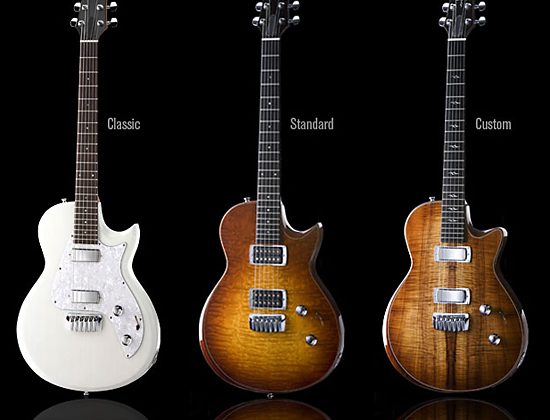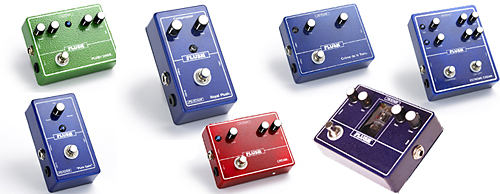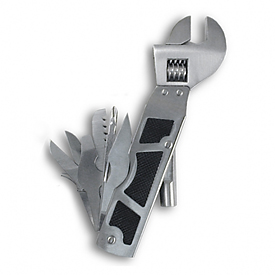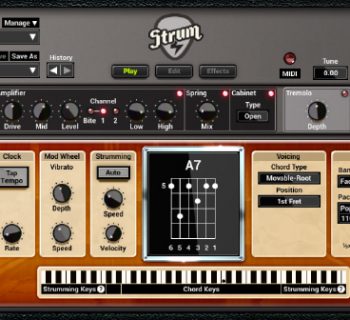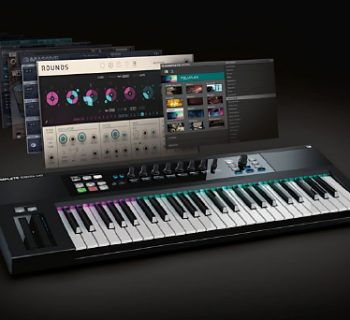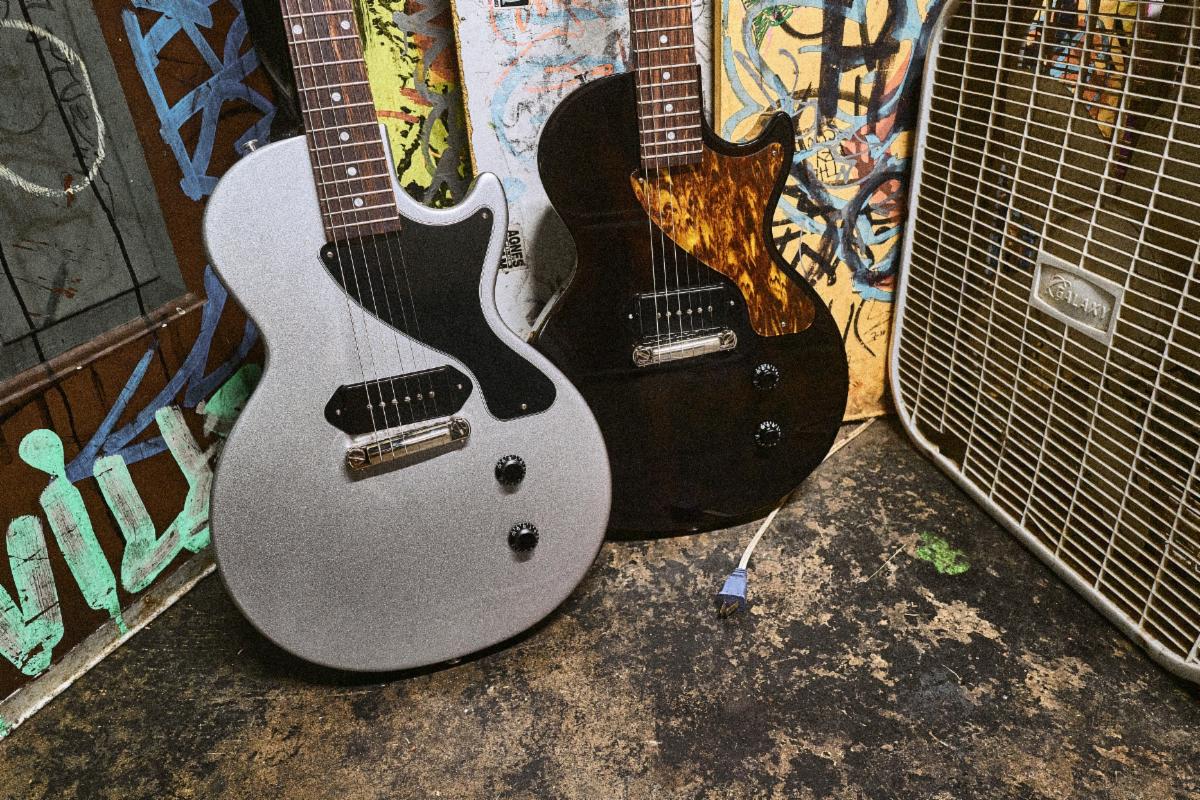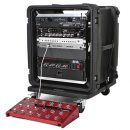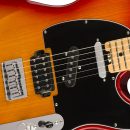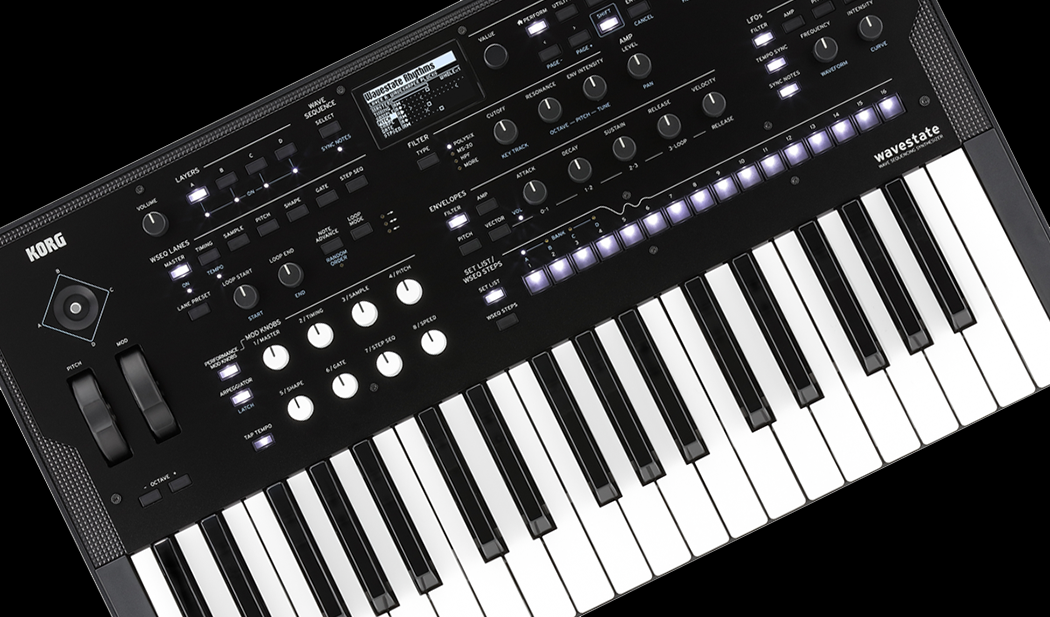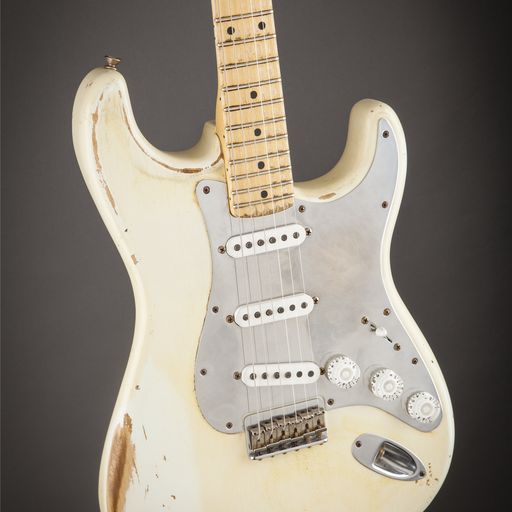 In this day and age, guitars and guitar makers are plentiful — so plentiful, in fact, that you sometimes have to stop and ask, “Does the market have room for yet another electric guitar line?” But of course a question like that only lingers in your brain for a millisecond before musicians like all of us respond with “Of course there’s room for more guitars! Bring it on!” And in the case of the new electric guitar line from renowned acoustic guitar builder Taylor Guitars, there’s plenty of room for the new line, because these instruments are truly new instruments — they aren’t the familiar repackaging of standard parts that everyone else is using.
In this day and age, guitars and guitar makers are plentiful — so plentiful, in fact, that you sometimes have to stop and ask, “Does the market have room for yet another electric guitar line?” But of course a question like that only lingers in your brain for a millisecond before musicians like all of us respond with “Of course there’s room for more guitars! Bring it on!” And in the case of the new electric guitar line from renowned acoustic guitar builder Taylor Guitars, there’s plenty of room for the new line, because these instruments are truly new instruments — they aren’t the familiar repackaging of standard parts that everyone else is using.
Due to Taylor’s excellent reputation in the acoustic guitar market, and our love of their T5 acoustic-electric models, we couldn’t wait to experience their new solid-body creations. Our suspense was alleviated when four Taylor SolidBody guitars showed up in our studios for review.
| Category | Value | Rating |
| Features | 20% | |
| Usability | 25% | |
| Sound | 25% | |
| Documentation & Support | 10% | |
| Price | 20% | |
| OVERALL RATING = 3.6, which earns it a WIHO Award! 3.6 stars or better: Outstanding, WIHO Award 3 stars or better: Worth considering 2 stars or better: Suited to specific needs 1 star or less: Not recommended |
||
Taylor not only met our expectations in providing an excellent guitar from both the playability and sound standpoints, but they reengineered almost every aspect of the traditional electric guitar to achieve those goals. The resulting instruments feature some pretty astounding modern technology packed into fresh new designs that have a classic vibe married to cool, modern appointments.
Features
From a cosmetic standpoint, the Taylor SolidBody instruments feature flawless craftsmanship in keeping with their acoustic instrument bretheren. The basic design and common features of the Taylor SolidBody guitar can be seen across their Classic, Standard and Custom models.
Each SolidBody features a single-cutaway body style measuring a scale length of 24-7/8.” The neck provides twenty-two frets of playability and, depending on the model, is topped with either a rosewood or ebony fingerboard measuring a 15” radius.
 One of the most innovative features we learned about on the Taylor SolidBody guitar is its new single-bolt T-lock neck Joint. This feature provides true lock-into-place technology by pulling the neck into the body and also downward towards the bridge to ensure stability and perfect neck alignment.
One of the most innovative features we learned about on the Taylor SolidBody guitar is its new single-bolt T-lock neck Joint. This feature provides true lock-into-place technology by pulling the neck into the body and also downward towards the bridge to ensure stability and perfect neck alignment.
Another beautifully reengineered component is the Taylor bridge. Bold in chrome and sleek without any sharp edges, you just can’t wait to rest the heel of your palm on it. The all-aluminum bridge provides excellent comfort as well as locked-down intonation. Unlike most electric bridge systems in which settings can drift once all the strings are removed, the Taylor bridge allows you to set the intonation and lock down the saddle screws from the rear access panel of the guitar. Once the saddles are locked down, they will not allow any variation in settings – even with all strings removed (which makes cleaning your instrument a real treat).
 The bridge also allows for angle adjustment both in front and rear of the bridge, and the break angle for each string is set by the shape of each saddle. So no matter how you adjust the bridge angle, the break angle for each string is permanent.
The bridge also allows for angle adjustment both in front and rear of the bridge, and the break angle for each string is set by the shape of each saddle. So no matter how you adjust the bridge angle, the break angle for each string is permanent.
Happy accidents lead to real innovation. The familiar Post-It note was developed as a result of engineers at 3M trying to create the ultimate super-glue (clearly they missed the mark), and it was a similar happy accident that gave birth to these electric guitars. Taylor engineers were developing pickups for the T5 electric-acoustic guitars, and some of that pickup development resulted in pickups that just weren’t right for those guitars… but were worthy of use on something a little bit more… electric!
From that research and development, the Taylor Style 1 ¾” humbucker pickup and the Taylor Style 2 full-size humbucker pickup were born, followed by these exciting new instruments on which to hear them.
Each SolidBody is equipped with a five-way pickup selector switch and a Master Volume and Tone control. Position 1 provides the full neck position; Position 2 splits each humbucker and uses the inside coils of each pickup in parallel; Position 3 selects the full neck pickup with the inside coil of the bridge pickup; Position 4 selects the inside coil of each humbucker in series; and Position 5 selects the full bridge pickup.
The Volume and Tone controls are all chrome, top hat in design, and come supplied with optional rubber O-rings that, when applied, provide extra traction for “pinky power” on-the-fly adjustments.
 Another truly unique innovation is in the safety department — the Taylor SolidBody guitar just may save your life one day! We were extremely impressed and intrigued by the Fused String Ground feature, now present in all Taylor guitars with onboard electronics. The “Blue Spark” is commonly experienced as a result of improper grounding or wiring when a guitarist touches their strings (while connected to their amp) and comes in contact with a microphone with a ground fault, resulting in a dangerous amount of voltage passing through your body.
Another truly unique innovation is in the safety department — the Taylor SolidBody guitar just may save your life one day! We were extremely impressed and intrigued by the Fused String Ground feature, now present in all Taylor guitars with onboard electronics. The “Blue Spark” is commonly experienced as a result of improper grounding or wiring when a guitarist touches their strings (while connected to their amp) and comes in contact with a microphone with a ground fault, resulting in a dangerous amount of voltage passing through your body.
Should you be unfortunate enough to experience this unpleasant (and dangerous) shock, you’ll be pleased to know that the SolidBody guitars contain a five-milliamp fuse wired to the switch plate on the inside of the guitar. During a ground fault, the fuse will blow, eliminating the completion of the electrical circuit. Not to worry — after you’re done attacking the sound guy or club owner, your guitar will still function, albeit with the presence of some additional hum until the fuse is replaced, but at least you will have avoided a trip to the hospital.
Now that we discussed the common features found on the Taylor SolidBody Classic, Standard and Custom electric guitars, let’s take a look at the unique and defining features of each guitar.
One of the most identifiable features of the Taylor Custom SolidBody guitars is the inset top — a thinly sliced piece of exotic wood commonly known as veneer. Our two Custom review models came with a Koa top and Walnut top. The richness of these fine woods is undeniable – and the price of the guitar would far exceed our pockets if it weren’t for Taylor’s innovative technique of insetting these fine woods into the tops.
This feature also enabled Taylor to define the shape of the single-cutaway body with white binding by outlining the outer edge of the veneer insert while still maintaining beveled edges and sleek contours. Much like the inset process of the Venetian wood, the binding is inset as well.
Taylor Guitars excel at understanding the relationship between chamber and tone. Having proven their expertise in this are through their acoustic guitar line, Taylor incorporated some of their chambering technology in their solidbody guitar. Tone chambering obviously allows for weight reduction of the overall guitar, but also provides an acoustic bloom and added sustain to the overall sound of the instrument.
Listed below are additional unique, defining features of each Taylor Solidbody guitar:
| Features |
Classic |
Standard |
Custom |
| Body Wood |
Swamp Ash |
Tamo Ash |
Sapele |
| Neck Wood |
Maple |
Mahogany |
Mahogany |
| Neck Inlays |
Dot Inlay |
Dot Inlay |
Diamond Inlay |
| Fretboard |
Rosewood |
Ebony |
Ebony |
| Pickups |
Taylor Style 1 |
Taylor Style 2 |
Taylor Style 1 |
| Pickguard |
Crushed Pearl |
N/A |
N/A |
| Finish |
Trans(parent) White, Trans Red, Black, or Natural |
Aged Cherry, Natural Edgeburst |
Koa and Walnut/Exotic woods |
Usability
The Taylor SolidBody guitars feel great, particularly in the playability of their necks. We found precision in their neck alignment, consistency in string action from top to bottom of the neck, and dead-on intonation.
Do you sweat a lot on stage and have trouble managing your volume and tone controls? Taylor provides an excellent solution via black rubber O-rings that fit over the top hat control knobs. If grip is what you need, this technology provides an excellent solution, and also adds a subtle cosmetic detail that looked as sharp as the rest of the instruments.
We found the intonation access and setting procedures to be easily executed – the instruments are very easy for a competent musician to adjust if you have some basic experience adjusting other typical electric guitars. The locking down of the intonation, once set, is extremely beneficial. We can’t remember the last time we removed all strings at once for a neck cleaning and didn’t have to make a single adjustment upon completion of the restringing.
The instruments weigh approximately six to seven pounds and are well balanced. They were comfortable to play both standing and seated for extended periods.
Sound
We found the Taylor Solidbody electrics provided not only vintage tones sure to satisfy the old-school guitarist, but thanks to some uniqueness in the sonic character of these Taylors, they will also appeal to modern players looking to create their own voice. The only concern you’ll have is which tone you prefer based on the pickup type.
The application of five-way pickup selection provided excellent flexibility and a wide range of options in selecting our favorite tones. From Strat-like, single-coil configurations to full all-out humbucker tone and response, and lots of great in-between stuff, we found a wide range of usable tones that suited just about any musical genre.
The Taylor Classic and Custom models are fitted with the Taylor Style 1 pickup – a slightly smaller ¾” size humbucker pickup providing the output, punch and gain of a full-size humbucker but tighter in response and less dirty.
When we plugged our Taylor Classic and Custom models into a Mesa/Boogie Lone Star amp, we found that the clean tones were amazingly clean and pristine, providing brilliance and sparkle to the overall spectrum. In conjunction with the five-way selection switch, we were able to get a huge range of sounds comparable to both single and double coil configurations.
Though we couldn’t quite match the low-end, full-bodied tone of a Les Paul or the precise bell-like tone of a Stratocaster in these models, this was probably as close as one could get to both of those familiar tones from a single instrument without requiring a guitar swap.
The SolidBody Classic and Custom guitars definitely contained a voice of their own. With the additional tonal-sculpting options found in the Tone control, the variations were endless. The only comparison or analogy we could make would be to take all the possibilities of a five position switch using humbucker pickups and coil splitting combined with a wah-wah pedal to sweep in between all the frequencies of that spectrum – good luck choosing your favorite setting! If we had to compare this pickup to another type of pickup, it might fall somewhere between a P90 and a full-size humbucker pickup – rich in tone and vintage in response. The Taylor Classic and the Taylor Custom are capable of generating excellent vintage tones as well as creating some modern tones, too.
The other pickup option is the Style 2 full-size, open-face humbucker found in the Taylor SolidBody Standard. This option provided much of the same tonal characteristics as the Style 1 pickup, but definitely provided a heavier, dirtier tone suitable for more of a rock edge. Played through the clean channel of our Boogie, the Standard still provided great tone comparable to the Style 1 pickup, but the tonal difference of the pickups was more prevalent when playing through our dirty channel. The crunch tone was a little looser and provided additional sustain.
In combination with the five-way pickup selection switch, the Tone control offers an even wider spectrum of tonal possibilities. The first two-thirds of the tone control provides traditional treble and bass influence. But the final third setting provides tonal response focused on additional mids comparable to that of a wah-wah pedal. Though some flexibility may seem diminished by the absence of individual volume and tone controls for each pickup, the combination of coil splitting and configuration options provided by the five-way switch, matched to the Tone control with its somewhat unique sonic influence, should result in providing a huge palette of sound — it certainly did for us!
Documentation and Product Support
Taylor provides the basic documentation you would expect to accompany any new guitar purchase. Most important, the documentation explained the new design features to help us understand instrument set up and intonation adjustments, truss adjustments, and also applying the optional O-rings.
Taylor also provides excellent documentation and product support via their website. From the early history of Taylor guitars to reasons behind their new guitar design and engineering, you’ll find plenty of background reading online.
Price
The Taylor SolidBody electric guitars provide very good value. Taking into consideration the craftsmanship of the instruments and all the advanced technology and design, not to mention Taylor’s obvious attention to detail, you would be well advised to check these guitars out when it’s time for your next acquisition
- The SolidBody Classic ($1748.00 MSRP) can be found for approximately $1,300.00 retail.
- The SolidBody Standard ($2,398.00 MSRP) can be found for approximately $1,800.00 retail.
- The SolidBody Custom ($3,098.00 MSRP) can be found for approximately $2,300.00 retail.
Contact Information
Taylor Guitars
www.taylorelectricguitars.com
| Evaluation Short-List |
|

